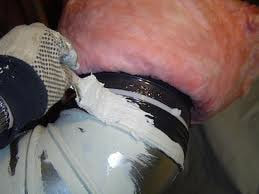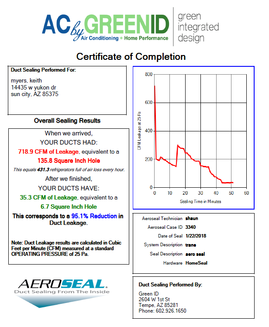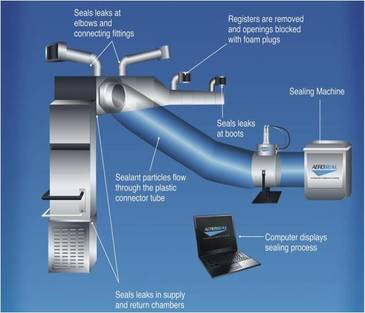Aeroseal Your Ductwork
|
Ductwork sealing with Aeroseal is a process that uses an injection polymer glue that is aerosolized in the duct system, sealing the ductwork from the inside. A manual seal still needs to be to complete the ductwork sealing process but Aeroseal is an effective method at closing all the gaps and holes in the ductwork. The Department of Energy and SRP estimate at least 20% of the air in the ductwork is lost from duct leaks.
Aeroseal may not be the best option for sealing the ductwork for your home. Ductwork replacement may be a better option is your home was built in the 1970's - 1980's. Here is a guide and Frequently Asked Questions about Aeroseal to help you make an informed decision. |
What questions should I ask my Aeroseal contractor?
If you are getting a cost estimate for Aeroseal, here are a list of questions you should ask them to ensure you are getting the right duct sealing method for your house for the most cost effective price.
- Is my ductwork completely accessible? If not, what parts are inaccessible? If your ductwork is completely accessible then YOU DO NOT NEED AEROSEAL. A manual sealing IS MORE EFFECTIVE THAN AEROSEAL.
- Where did you find leaks that Aeroseal will not seal? You want to know the rep did a through check of your ductwork and will communicate that to the Aeroseal technicians. Do not rely on the Aeroseal technicians to find the larger leaks. The rep should also let you know that all the drywall gap between the boot and drywall will be sealed by hand also. The drywall gap between the boot and drywall will not be sealed by Aeroseal.
- Is your company an Aeroseal dealer? You want the company selling you the Aerosealing and the company installing Aeroseal to be the same company. If they use subcontractors to do Aerosealing, communication can be spotty if there are special instructions that need to be communicated.
- How will the return ducts be sealed? The return ductwork should be sealed by hand with mastic. Many companies do not touch the return but sealing the leakage on the return is equally as important as the supply duct leakage.
Can Aeroseal fix my hot or cold rooms?
Despite what companies say, hot and cold rooms are rarely solved with a single solution approach. We have seen homeowners come out with the short end of the stick again and again from companies promising that Aerosealing your ductwork will fix comfort problems. The only way to know the root causes of comfort problems is to perform an energy audit and test your home first. Many companies that offer Aeroseal do not perform a good energy audit with the homeowner's interest in mind. Your home may have duct leakage but if your insulation is installed wrong, ductwork is sized wrong and airflow imbalanced, Aerosealing can make the hot rooms hotter and cold rooms colder.
How much will Aeroseal save me in energy costs?
When looking at how much energy savings you can expect with Aeroseal or ductwork sealing in general, you must keep in mind where energy is being used in your home. In Arizona, half of our energy use comes from air conditioning in the summer. An energy auditor can take a look at your energy bills and if an audit is performed, put all the data into an energy model and heat load calculation to estimate how much savings you can expect to see.
What's the difference between Aeroseal and manual ductwork sealing?
Companies that primary promote Aeroseal will say that Aeroseal is superior to manual ductwork sealing but we don't believe that is the case. Manual ductwork sealing can be applied thicker than Aerosealing and seals larger holes bigger than 5/8".
How long does Aeroseal last?
Aeroseal is guaranteed for 10 years. Mastic ductwork sealing is guarenteed for 50 years. I believe both applications can last for 50 plus years.
When should Aerosealing be used and when is manual ductwork sealing recommended?

Manual ductwork should be used:
Aeroseal the ductwork should be used:
- Within the first 3 feet of the air handler, furnace or package unit
- Gaps larger than 5/8". An energy auditor will be able to identify larger holes with a blower door test. It is typically not a good idea to rely on the Aeroseal technicians to find the larger holes since they typically just "blow and go."
- When the ductwork is 100% accessible.
- Manual ductwork sealing can be applied thicker, which is better than the thin coat of glue Aeroseal leaves.
Aeroseal the ductwork should be used:
- When the ductwork is not accessible for rectangular sheet metal ductwork in attics, walls and crawlspaces.
- The the ductwork travels between floor cavities and is inaccessible.
- The ductwork travels to an inaccessible part of the house (just because a large or inexperienced technician can't reach an area in the attic, does not mean it is inaccessible).
- The ductwork is extensively wrapped in metal wires and insulation.
Is the sealant used in Aeroseal safe?
Sealant used by Aeroseal is a water based, non-toxic and has been used in hospitals, surgery centers, and government institutions. UL approvals for UL 1381 for aerosol based technology – UL 723 for smoke and flame rating of 0 and UL 181 for mold growth. Primary component is Vinyl Acetate Polymer, used in water based paints, hair spray, and chewing gum. The primary component of Aeroseal has NO OSHA maximum VOC exposure limit.
How effective is Aeroseal?

Aeroseal is very effective at sealing both inaccessible leaks and the accessible ductwork leakage. The Aeroseal report will show where you leakage started at and how much the leakage was reduced. In most cases our technicians can seal more than 95% of the home's leakage on the supply ductwork. Aeroseal is not typically done on the return side but the return side is just as important as the supply registers.
Manual ductwork sealing can also achieve less than 1% leakage as measured by our blower door so you want to be sure you need Aerosealing before you make the investment because Aerosealing tends to be 50-100% higher in cost than manual duct sealing.
Manual ductwork sealing can also achieve less than 1% leakage as measured by our blower door so you want to be sure you need Aerosealing before you make the investment because Aerosealing tends to be 50-100% higher in cost than manual duct sealing.

